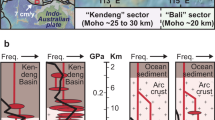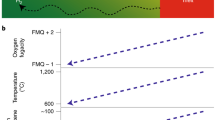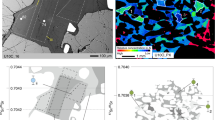Abstract
Magmatic volatiles (for example, water) are abundant in arc melts and exert fundamental controls on magma evolution, eruption dynamics and the formation of economic ore deposits. To constrain the H2O content of arc magmas, most studies have relied on measuring extrusive products and mineral-hosted melt inclusions. However, these methods have inherent limitations that obfuscate the full range of H2O in arc magmas. Here, we report secondary-ion mass spectrometry measurements of volatile (H2O, F, P, S, Cl) abundances in lower-crustal cumulate minerals from the Kohistan palaeo-arc (northwestern Pakistan) and determine H2O abundances of melts from which the cumulates crystallized. Pyroxenes retained magmatic H2O abundances and record damp (less than 1 wt% H2O) to hydrous (up to 10 wt% H2O) primitive melts. Subsequent crystal fractionation led to formation of super-hydrous melts with approximately 12–20 wt% H2O, predicted petrologically yet virtually absent from the melt-inclusion record. Porphyry copper deposits are probably a natural eventuality of fluid exsolution from super-hydrous melts, corroborating a growing body of evidence.
This is a preview of subscription content, access via your institution
Access options
Access Nature and 54 other Nature Portfolio journals
Get Nature+, our best-value online-access subscription
$29.99 / 30 days
cancel any time
Subscribe to this journal
Receive 12 print issues and online access
$259.00 per year
only $21.58 per issue
Buy this article
- Purchase on Springer Link
- Instant access to full article PDF
Prices may be subject to local taxes which are calculated during checkout





Similar content being viewed by others
Data availability
All data that support the findings of this study are presented herein or cited in the text and Methods. Arc melt-inclusion data for Fig. 5b were downloaded from the GEOROC Database (http://georoc.mpch-mainz.gwdg.de/georoc/) on 24 June 2020 as a precompiled file MELT_INCLUSIONS.csv and sorted. Geochemical data from this study available at PetDB, https://doi.org/10.26022/IEDA/112279.
Code availability
Code used in the generation of figures is available by request to the corresponding author.
References
Wallace, P. J., Plank, T., Edmonds, M. & Hauri, E. H. in The Encyclopedia of Volcanoes (ed. Sigurdsson, H.) 163–183 (Elsevier, 2015).
Mitchell, A. L., Gaetani, G. A., O’Leary, J. A. & Hauri, E. H. H2O solubility in basalt at upper mantle conditions. Contrib. Miner. Petrol. 172, 85 (2017).
Dobson, P. F., Skogby, H. & Rossman, G. R. Water in boninite glass and coexisting orthopyroxene: concentration and partitioning. Contrib. Mineral. Petrol. 118, 414–419 (1995).
Sisson, T. & Layne, G. H2O in basalt and basaltic andesite glass inclusions from four subduction-related volcanoes. Earth Planet Sci. Lett. 117, 619–635 (1993).
Plank, T., Kelley, K. A., Zimmer, M. M., Hauri, E. H. & Wallace, P. J. Why do mafic arc magmas contain ∼4 wt% water on average? Earth Planet Sci. Lett. 364, 168–179 (2013).
Gaetani, G. A., O’Leary, J. A., Shimizu, N., Bucholz, C. E. & Newville, M. Rapid reequilibration of H2O and oxygen fugacity in olivine-hosted melt inclusions. Geology 40, 915–918 (2012).
Portnyagin, M., Almeev, R., Matveev, S. & Holtz, F. Experimental evidence for rapid water exchange between melt inclusions in olivine and host magma. Earth Planet Sci. Lett. 272, 541–552 (2008).
Bucholz, C. E., Gaetani, G. A., Behn, M. D. & Shimizu, N. Post-entrapment modification of volatiles and oxygen fugacity in olivine-hosted melt inclusions. Earth Planet. Sci. Lett. 374, 145–155 (2013).
Annen, C., Blundy, J. & Sparks, R. The genesis of intermediate and silicic magmas in deep crustal hot zones. J. Petrol. 47, 505–539 (2006).
Goltz, A. E., Krawczynski, M. J., Gavrilenko, M., Gorbach, N. V. & Ruprecht, P. Evidence for superhydrous primitive arc magmas from mafic enclaves at Shiveluch volcano, Kamchatka. Contrib. Mineral. Petrol. 175, 115 (2020).
Grove, T. L. et al. Magnesian andesite and dacite lavas from Mt. Shasta, northern California: products of fractional crystallization of H2O-rich mantle melts. Contrib. Mineral. Petrol. 148, 542–565 (2005).
Krawczynski, M. J., Grove, T. L. & Behrens, H. Amphibole stability in primitive arc magmas: effects of temperature, H2O content, and oxygen fugacity. Contrib. Mineral. Petrol. 164, 317–339 (2012).
Zellmer, G. F. et al. Petrogenesis of antecryst-bearing arc basalts from the trans-Mexican volcanic belt: insights into along-arc variations in magma-mush ponding depths, H2O contents, and surface heat flux. Am. Mineral. 101, 2405–2422 (2016).
Prouteau, G. & Scaillet, B. Experimental constraints on the origin of the 1991 Pinatubo dacite. J. Petrol. 44, 2203–2241 (2003).
Carmichael, I. S. The andesite aqueduct: perspectives on the evolution of intermediate magmatism in west-central (105–99° W) Mexico. Contrib. Mineral. Petrol. 143, 641–663 (2002).
Lu, Y.-J., Loucks, R. R., Fiorentini, M. L., Yang, Z.-M. & Hou, Z.-Q. Fluid flux melting generated postcollisional high Sr/Y copper ore–forming water-rich magmas in Tibet. Geology 43, 583–586 (2015).
Laumonier, M., Gaillard, F., Muir, D., Blundy, J. & Unsworth, M. Giant magmatic water reservoirs at mid-crustal depth inferred from electrical conductivity and the growth of the continental crust. Earth Planet. Sci. Lett. 457, 173–180 (2017).
Tattitch, B., Chelle-Michou, C., Blundy, J. & Loucks, R. R. Chemical feedbacks during magma degassing control chlorine partitioning and metal extraction in volcanic arcs. Nat. Commun. 12, 1774 (2021).
O’Leary, J. A., Gaetani, G. A. & Hauri, E. H. The effect of tetrahedral Al3+ on the partitioning of water between clinopyroxene and silicate melt. Earth Planet. Sci. Lett. 297, 111–120 (2010).
Tahirkheli, R. A. K. & Jan, M. Q. Geology of Kohistan, Karakorum Himalaya, northern Pakistan. Geol. Bull. Univ. Peshawar 11, 1–30 (1979).
Jagoutz, O. & Schmidt, M. W. The formation and bulk composition of modern juvenile continental crust: the Kohistan arc. Chem. Geol. 298, 79–96 (2012).
Jagoutz, O. et al. Petrology and mineral chemistry of lower crustal intrusions: the Chilas Complex, Kohistan (NW Pakistan). J. Petrol. 48, 1895–1953 (2007).
Loucks, R. R. Restoration of the elemental and stable-isotopic compositions of diffusionally altered minerals in slowly cooled rocks. Contrib. Mineral. Petrol. 124, 346–358 (1996).
Müntener, O. & Ulmer, P. Arc crust formation and differentiation constrained by experimental petrology. Am. J. Sci. 318, 64–89 (2018).
Ulmer, P., Kaegi, R. & Müntener, O. Experimentally derived intermediate to silica-rich arc magmas by fractional and equilibrium crystallization at 1·0 GPa: an evaluation of phase relationships, compositions, liquid lines of descent and oxygen fugacity. J. Petrol. 59, 11–58 (2018).
Jagoutz, O., Muntener, O., Schmidt, M. W. & Burg, J. P. The roles of flux- and decompression melting and their respective fractionation lines for continental crust formation: evidence from the Kohistan arc. Earth Planet Sci. Lett. 303, 25–36 (2011).
Schaltegger, U., Zeilinger, G., Frank, M. & Burg, J. P. Multiple mantle sources during island arc magmatism: U–Pb and Hf isotopic evidence from the Kohistan arc complex, Pakistan. Terra Nova 14, 461–468 (2002).
Bouilhol, P., Jagoutz, O., Hanchar, J. M. & Dudas, F. O. Dating the India–Eurasia collision through arc magmatic records. Earth Planet. Sci. Lett. 366, 163–175 (2013).
Burg, J. P., Jagoutz, O., Dawood, H. & Hussain, S. S. Precollision tilt of crustal blocks in rifted island arcs: structural evidence from the Kohistan Arc. Tectonics 25, TC5005 (2006).
Demouchy, S., Jacobsen, S. D., Gaillard, F. & Stern, C. R. Rapid magma ascent recorded by water diffusion profiles in mantle olivine. Geology 34, 429–432 (2006).
Le Roux, V. et al. Postmelting hydrogen enrichment in the oceanic lithosphere. Sci. Adv. 7, eabf6071 (2021).
Peslier, A. H. & Luhr, J. F. Hydrogen loss from olivines in mantle xenoliths from Simcoe (USA) and Mexico: mafic alkalic magma ascent rates and water budget of the sub-continental lithosphere. Earth Planet. Sci. Lett. 242, 302–319 (2006).
Xu, Y. et al. Reconciling the discrepancy between the dehydration rates in mantle olivine and pyroxene during xenolith emplacement. Geochim. Cosmochim. Acta 267, 179–195 (2019).
Ferriss, E., Plank, T. & Walker, D. Site-specific hydrogen diffusion rates during clinopyroxene dehydration. Contrib. Mineral. Petrol. 171, 55 (2016).
Schaffer, L. A. et al. Effects of melting, subduction-related metasomatism, and sub-solidus equilibration on the distribution of water contents in the mantle beneath the Rio Grande Rift. Geochim. Cosmochim. Acta 266, 351–381 (2019).
Hauri, E. H., Gaetani, G. A. & Green, T. H. Partitioning of water during melting of the Earth’s upper mantle at H2O-undersaturated conditions. Earth Planet Sci. Lett. 248, 715–734 (2006).
Berndt, J. et al. A combined rapid-quench and H2-membrane setup for internally heated pressure vessels: description and application for water solubility in basaltic melts. Am. Mineral. 87, 1717–1726 (2002).
Hamilton, D., Burnham, C. W. & Osborn, E. The solubility of water and effects of oxygen fugacity and water content on crystallization in mafic magmas. J. Petrol. 5, 21–39 (1964).
Jagoutz, O., Müntener, O., Burg, J.-P., Ulmer, P. & Jagoutz, E. Lower continental crust formation through focused flow in km-scale melt conduits: the zoned ultramafic bodies of the Chilas Complex in the Kohistan island arc (NW Pakistan). Earth Planet. Sci. Lett. 242, 320–342 (2006).
Jagoutz, O. E. Construction of the granitoid crust of an island arc. Part II: a quantitative petrogenetic model. Contrib. Mineral. Petrol. 160, 359–381 (2010).
Newman, S. & Lowenstern, J. B. VolatileCalc: a silicate melt–H2O–CO2 solution model written in Visual Basic for Excel. Comput. Geosci. 28, 597–604 (2002).
Alletti, M. et al. Chlorine partitioning between a basaltic melt and H2O–CO2 fluids at Mount Etna. Chem. Geol. 263, 37–50 (2009).
Lee, C.-T. A. & Tang, M. How to make porphyry copper deposits. Earth Planet. Sci. Lett. 529, 115868 (2020).
Hedenquist, J. W., Arribas, A. & Reynolds, T. J. Evolution of an intrusion-centered hydrothermal system; Far Southeast-Lepanto porphyry and epithermal Cu-Au deposits, Philippines. Econ. Geol. 93, 373–404 (1998).
Rezeau, H. & Jagoutz, O. The importance of H2O in arc magmas for the formation of porphyry Cu deposits. Ore Geol. Rev. 126, 103744 (2020).
Klemm, L. M., Pettke, T. & Heinrich, C. A. Fluid and source magma evolution of the Questa porphyry Mo deposit, New Mexico, USA. Miner. Depos. 43, 533 (2008).
Loucks, R. R. Deep entrapment of buoyant magmas by orogenic tectonic stress: its role in producing continental crust, adakites, and porphyry copper deposits. Earth Sci. Rev. 220, 103744 (2021).
Kodaira, S. et al. Seismological evidence for variable growth of crust along the Izu intraoceanic arc. J. Geophys. Res. Solid Earth 112, B05104 (2007).
Kodaira, S. et al. New seismological constraints on growth of continental crust in the Izu-Bonin intra-oceanic arc. Geology 35, 1031–1034 (2007).
Behn, M. D. & Kelemen, P. B. Stability of arc lower crust: insights from the Talkeetna arc section, south central Alaska, and the seismic structure of modern arcs. J. Geophys. Res. Solid Earth 111, B11207 (2006).
O’Reilly, S. Y. & Griffin, W. Moho vs crust–mantle boundary: evolution of an idea. Tectonophysics 609, 535–546 (2013).
Müntener, O. & Ulmer, P. Experimentally derived high‐pressure cumulates from hydrous arc magmas and consequences for the seismic velocity structure of lower arc crust. Geophys. Res. Lett. 33, L21308 (2006).
Portnyagin, M., Hoernle, K., Plechov, P., Mironov, N. & Khubunaya, S. Constraints on mantle melting and composition and nature of slab components in volcanic arcs from volatiles (H2O, S, Cl, F) and trace elements in melt inclusions from the Kamchatka Arc. Earth Planet Sci. Lett. 255, 53–69 (2007).
Rose-Koga, E. F. et al. Volatile (F and Cl) concentrations in Iwate olivine-hosted melt inclusions indicating low-temperature subduction. Earth Planets Space 66, 81 (2014).
Rose-Koga, E. F. et al. Mantle source heterogeneity for South Tyrrhenian magmas revealed by Pb isotopes and halogen contents of olivine-hosted melt inclusions. Chem. Geol. 334, 266–279 (2012).
Sadofsky, S. J., Portnyagin, M., Hoernle, K. & van den Bogaard, P. Subduction cycling of volatiles and trace elements through the Central American volcanic arc: evidence from melt inclusions. Contrib. Mineral. Petrol. 155, 433–456 (2008).
GEOROC Compilation: Melt Inclusions. Goettingen Research Online 1 (DIGIS, accessed 24 June 2020); http://georoc.mpch-mainz.gwdg.de/georoc/
Sun, C. & Liang, Y. A REE-in-garnet-clinopyroxene thermobarometer for eclogites, granulites and garnet peridotites. Chem. Geol. 393–394, 79–92 (2015).
Urann, B. M., Le Roux, V., John, T., Beaudoin, G. M. & Barnes, J. D. The distribution and abundance of halogens in eclogites: an in situ SIMS perspective of the Raspas Complex (Ecuador). Am. Mineral. 105, 307–318 (2020).
Kumamoto, K. M., Warren, J. M. & Hauri, E. H. New SIMS reference materials for measuring water in upper mantle minerals. Am. Mineral. 102, 537–547 (2017).
Abers, G. A. & Hacker, B. R. A MATLAB toolbox and Excel workbook for calculating the densities, seismic wave speeds, and major element composition of minerals and rocks at pressure and temperature. Geochem. Geophys. Geosyst. 17, 616–624 (2016).
Pearce, N. J. et al. A compilation of new and published major and trace element data for NIST SRM 610 and NIST SRM 612 glass reference materials. Geostand. Newsl. 21, 115–144 (1997).
Jackson, S. E. LAMTRACE data reduction software for LA-ICP-MS. Mineral. Assoc. Can. Short Course Ser. 40, 305–307 (2008).
Lee, C.-T. A. Laser Ablation ICP-MS: Data Reduction (2006); www.cintylee.org/s/LASERABLATIONICP.pdf
Urann, B. et al. Fluorine and chlorine in mantle minerals and the halogen budget of the Earth’s mantle. Contrib. Mineral. Petrol. 172, 51 (2017).
Joachim, B. et al. Effect of water on the fluorine and chlorine partitioning behavior between olivine and silicate melt. Contrib. Mineral. Petrol. 172, 15 (2017).
Dalou, C., Koga, K. T., Le Voyer, M. & Shimizu, N. Contrasting partition behavior of F and Cl during hydrous mantle melting: implications for Cl/F signature in arc magmas. Prog. Earth Planet. Sci. 1, 26 (2014).
Acknowledgements
We thank B. Monteleone and N. Chatterjee for their technical expertise on the Cameca 1280 at the Northeast National Ion Microprobe Facility at WHOI and electron microprobe at MIT, respectively. We thank S. Parman, W. J. Collins and R. Loucks for their comments on previous versions of the manuscript.
Author information
Authors and Affiliations
Contributions
B.M.U. conceived the study. B.M.U. and V.L.R. collected and interpreted the data and wrote the manuscript. O.J. and O.M. provided samples, data and geochemical models. B.M.U., V.L.R., M.D.B. and E.J.C. acquired financial support. All authors contributed to editing the manuscript. Funding for this study was supported by the Woods Hole Oceanographic Institution Ocean Venture Fund to B.M.U., NSF awards EAR-P&G #1839128 and EAR-P&G/Geophysics #1855302 to V.L.R. and EAR-18-55430 to M.D.B. and E.J.C. V.L.R. also acknowledges the support from the Visiting Scholar at SCIENCE programme at the University of Copenhagen, Denmark. B.M.U. also acknowledges continued support from NSF OCE Post-doctoral Research Fellow grant (#2126559).
Corresponding author
Ethics declarations
Competing interests
The authors declare no competing interests.
Peer review
Peer review information
Nature Geoscience thanks Stephen Parman, William Collins and Robert Loucks for their contribution to the peer review of this work. Primary Handling Editor: Rebecca Neely, in collaboration with the Nature Geoscience team.
Additional information
Publisher’s note Springer Nature remains neutral with regard to jurisdictional claims in published maps and institutional affiliations.
Supplementary information
Supplementary Information
Sample descriptions, analytical techniques, partition coefficient calculations, crystal fractionation model details, crystallization correction, inter-mineral partitioning, additional figures and analytical calibration curves.
Supplementary Table 1
Sample locations, pressure and temperature estimates.
Supplementary Table 2
Volatile abundances by phase (SIMS).
Supplementary Table 3
Chilas modal abundances.
Supplementary Table 4
Volatile- and major-element analyses of individual measurements.
Supplementary Table 5
Clinopyroxene and garnet trace-element abundances.
Supplementary Table 6
Equilibrium crystallization model (Chilas).
Rights and permissions
About this article
Cite this article
Urann, B.M., Le Roux, V., Jagoutz, O. et al. High water content of arc magmas recorded in cumulates from subduction zone lower crust. Nat. Geosci. 15, 501–508 (2022). https://doi.org/10.1038/s41561-022-00947-w
Received:
Accepted:
Published:
Issue Date:
DOI: https://doi.org/10.1038/s41561-022-00947-w



